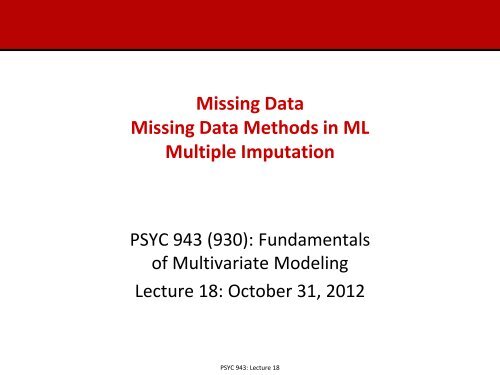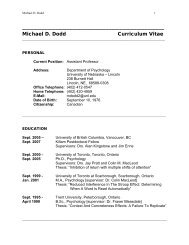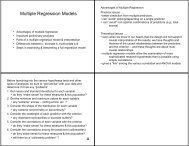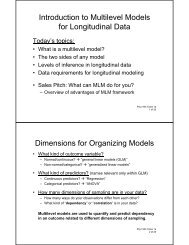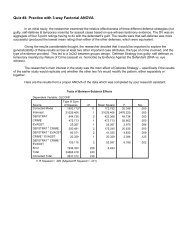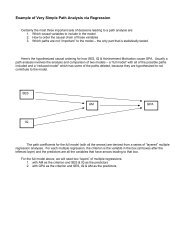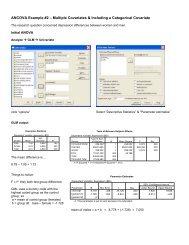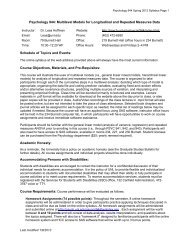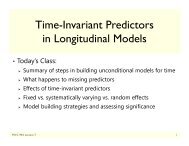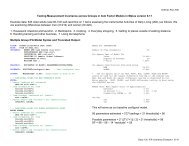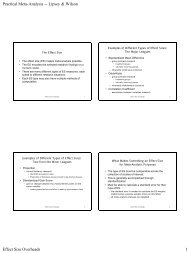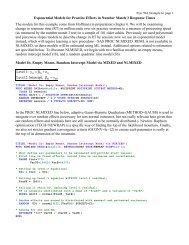Missing Data, Handing Missing Data via Maximum Likelihood, How ...
Missing Data, Handing Missing Data via Maximum Likelihood, How ...
Missing Data, Handing Missing Data via Maximum Likelihood, How ...
Create successful ePaper yourself
Turn your PDF publications into a flip-book with our unique Google optimized e-Paper software.
<strong>Missing</strong> <strong>Data</strong><strong>Missing</strong> <strong>Data</strong> Methods in MLMultiple ImputationPSYC 943 (930): Fundamentalsof Multivariate ModelingLecture 18: October 31, 2012PSYC 943: Lecture 18
Example <strong>Data</strong> #1• To demonstrate some of the ideas of types of missing data, let’sconsider a situation where you have collected two variables:‣ IQ scores‣ Job performance• Imagine you are an employer looking to hire employees for a jobwhere IQ is importantPSYC 943: Lecture 18 3
TYPES OF MISSING DATAPSYC 943: Lecture 18 5
Our Notational Setup• Let’s let D denote our data matrix, which will include dependent (Y)and independent (X) variablesD = X, Y• Problem: some elements of D are missingPSYC 943: Lecture 18 6
<strong>Missing</strong>ness Indicator Variables• We can construct an alternate matrix M consisting of indicators ofmissingness for each element in our data matrix DM ii = 0 if the i tt observation’s j tt variable is not missingM ii = 1 if the i tt observation’s j tt variable is missing• Let M ooo and M mmm denote the observed and missing parts of MM = {M ooo , M mmm }PSYC 943: Lecture 18 7
A (More) Formal MCAR Definition• Our missing data indicators, M are statistically independent of ourobserved data DP M|D = P Mthis comes from how independence works with pdfs• Like saying a missing observation is due to pure randomness(i.e., flipping a coin)PSYC 943: Lecture 18 10
Using Statistical Methods with <strong>Missing</strong> <strong>Data</strong>• <strong>Missing</strong> data can alter your analysis results dramaticallydepending upon:1. The type of missing data2. The type of analysis algorithm• The choice of an algorithm and missing data method is important inavoiding issues due to missing dataPSYC 943: Lecture 18 18
Evaluation of <strong>Missing</strong> <strong>Data</strong> in PROC MIXED(and pretty much all other packages)• If the dependent variables are missing, PROC MIXED automaticallyskips those variables in the likelihood‣ The REPEATED statement specifies observations with the same subject ID –and uses the non-missing observations from that subject only• If independent variables are missing, however, PROC MIXED useslistwise deletion‣ If you have missing IVs, this is a problem‣ You can sometimes phrase IVs as DVs, though• SAS Syntax (identical to when you have complete data):PSYC 943: Lecture 18 26
Analysis of MCAR <strong>Data</strong> with PROC MIXED• Covariance matrices from slide #4 (MIXED is closer to complete):MCAR <strong>Data</strong> (Pairwise Deletion)Complete <strong>Data</strong>IQ 115.6 19.4IQ 189.6 19.5Performance 19.4 8.0Performance 19.5 6.8• Estimated R matrix from PROC MIXED:• Output for each observation (obs #1 = missing, obs #2 = complete):PSYC 943: Lecture 18 27
MCAR Analysis: Estimated Fixed Effects• Estimated mean vectors:Variable• Estimated fixed effects:MCAR <strong>Data</strong>(pairwise deletion)IQ 93.73 100Performance 10.6 10.35Complete <strong>Data</strong>• Means – IQ = 89.36+10.64 = 100; Performance = 10.64PSYC 943: Lecture 18 28
Analysis of MAR <strong>Data</strong> with PROC MIXED• Covariance matrices from slide #4 (MIXED is closer to complete):MAR <strong>Data</strong> (Pairwise DeletionIQ 130.2 19.5Performance 19.5 7.3Complete <strong>Data</strong>IQ 189.6 19.5Performance 19.5 6.8• Estimated R matrix from PROC MIXED:• Output for each observation (obs #1 = missing, obs #10 = complete):PSYC 943: Lecture 18 29
Additional Issues with <strong>Missing</strong> <strong>Data</strong> and <strong>Maximum</strong> <strong>Likelihood</strong>• Given the structure of the missing data, the standard errors of theestimated parameters may be computed differently‣ Standard errors come from -1*inverse information matrix• Information matrix = matrix of second derivatives = hessian• Several versions of this matrix exist‣ Some based on what is expected under the model• The default in SAS – good only for MCAR data‣ Some based on what is observed from the data• Empirical option in SAS – works for MAR data (only for fixed effects)• Implication: some SEs may be biased if data are MAR‣ May lead to incorrect hypothesis test results‣ Correction needed for likelihood ratio/de<strong>via</strong>nce test statistics• Not available in SAS; available for some models in MplusPSYC 943: Lecture 18 31
When ML Goes Bad…• For linear models with missing dependent variable(s) PROC MIXEDand almost every other stat package works great‣ ML “skips” over the missing DVs in the likelihood function, using only thedata you have observed• For linear models with missing independent variable(s), PROCMIXED and almost every other stat package uses list-wise deletion‣ Gives biased parameter estimates under MARPSYC 943: Lecture 18 32
Options for MAR for Linear Models with<strong>Missing</strong> Independent Variables1. Use ML Estimators and hope for MCAR2. Rephrase IVs as DVs‣ In SAS: hard to do, but possible for some models• Dummy coding, correlated random effects• Rely on properties of how correlations/covariances are related to linear modelcoefficients β‣ In Mplus: much easier…looks more like a structural equation model• Predicted variables then function like DVs in MIXED3. Impute IVs (multiple times) and then use ML Estimators‣ Not usually a great idea…but often the only optionPSYC 943: Lecture 18 33
ANOTHER EXAMPLE DATA SETPSYC 943: Lecture 18 34
Today’s Example <strong>Data</strong> #2• Three variables were collected from a sample of 31 men in a courseat NC State‣ Oxygen: oxygen intake, ml per kg body weight, per mintue‣ Runtime: time to run 1.5 miles in minutes‣ Runpulse: heart rate while running• The research question: how does oxygen intake vary as a function ofexertion (running time and running heart rate)• The problem: some of the data are missingPSYC 943: Lecture 18 35
Descriptive Statistics of <strong>Missing</strong> <strong>Data</strong>• Descriptive statistics of our data:• Patterns of missing data:PSYC 943: Lecture 18 36
Comparing <strong>Missing</strong> and Not <strong>Missing</strong>OxygenRunning TimePulse RatePSYC 943: Lecture 18 37
HOW NOT TOHANDLE MISSING DATAPSYC 943: Lecture 18 38
Bad Ways to Handle <strong>Missing</strong> <strong>Data</strong>• Dealing with missing data is important, as the mechanisms youchoose can dramatically alter your results• This point was not fully realized when the first methods for missingdata were created‣ Each of the methods described in this section shouldnever be used‣ Given to show perspective – and to allow you to understand what happensif you were to choose eachPSYC 943: Lecture 18 39
Deletion Methods• Deletion methods are just that: methods that handle missing databy deleting observations‣ Listwise deletion: delete the entire observation if any values are missing‣ Pairwise deletion: delete a pair of observations if either of the values aremissing• Assumptions: <strong>Data</strong> are MCAR• Limitations:‣ Reduction in statistical power if MCAR‣ Biased estimates if MAR or MNARPSYC 943: Lecture 18 40
Listwise Deletion• Listwise deletion discards all of the data from an observation if oneor more variables are missing• Most frequently used in statistical software packages that are notoptimizing a likelihood function (need ML)• In linear models:‣ SAS GLM list-wise deletes cases where IVs or DVs are missingPSYC 943: Lecture 18 41
Listwise Deletion Example• If you wanted to predict Oxygen from Running Time and Pulse Rateyou could:‣ Start with one variable (running time):‣ Then add the other (running time + pulse rate):• The nested-model comparison test cannot be formed‣ Degrees of freedom error changes as missing values are omittedPSYC 943: Lecture 18 42
Pairwise Deletion• Pairwise deletion discards a pair of observations if either oneis missing‣ Different from listwise: uses more data (rest of data not thrown out)• Assumes: MCAR• Limitations:‣ Reduction in statistical power if MCAR‣ Biased estimates if MAR or MNAR• Can be an issue when forming covariance/correlation matrices‣ May make them non-invertible, problem if used as input into statisticalproceduresPSYC 943: Lecture 18 43
Pairwise Deletion Example• Covariance Matrix from PROC CORR (see the different DF):PSYC 943: Lecture 18 44
Single Imputation Methods• Single imputation methods replace missing data with sometype of value‣ Single: one value used‣ Imputation: replace missing data with value• Upside: can use entire data set if missing values are replaced• Downside: biased parameter estimates and standard errors (even ifmissing is MCAR)‣ Type-I error issues• Still: never use these techniquesPSYC 943: Lecture 18 45
Unconditional Mean Imputation• Unconditional mean imputation replaces the missing values of avariable with its estimated mean‣ Unconditional = mean value without any input from other variables• Example: missing Oxygen = 47.1; missing RunTime = 10.7;missing RunPulse = 171.9Before Single Imputation:After Single Imputation:• Notice: uniformly smaller standard de<strong>via</strong>tionsPSYC 943: Lecture 18 46
Conditional Mean Imputation (Regression)• Conditional mean imputation uses regression analyses to imputemissing values‣ The missing values are imputed using the predicted values in eachregression (conditional means)• For our data we would form regressions for each outcome using theother variables‣ OXYGEN = β 01 + β 11 *RUNTIME + β 21 *PULSE‣ RUNTIME = β 02 + β 12 *OXYGEN + β 22 *PULSE‣ PULSE = β 03 + β 13 *OXYGEN + β 23 *RUNTIME• More accurate than unconditional mean imputation‣ But still provides biased parameters and SEsPSYC 943: Lecture 18 47
Stochastic Conditional Mean Imputation• Stochastic conditional mean imputation adds a random componentto the imputation‣ Representing the error term in each regression equation‣ Assumes MAR rather than MCAR• Again, uses regression analyses to impute data:‣ OXYGEN = β 01 + β 11 *RUNTIME + β 21 *PULSE + Error‣ RUNTIME = β 02 + β 12 *OXYGEN + β 22 *PULSE + Error‣ PULSE = β 03 + β 13 *OXYGEN + β 23 *RUNTIME + Error• Error is random: drawn from a normal distribution‣ Zero mean and variance equal to residual variance σ e2forrespective regressionPSYC 943: Lecture 18 48
Imputation by Proximity: Hot Deck Matching• Hot deck matching uses real data – from other observations as itsbasis for imputing• Observations are “matched” using similar scores on variables in thedata set‣ Imputed values come directly from matched observations• Upside: Helps to preserve univariate distributions; gives data in anappropriate range• Downside: biased estimates (especially of regression coefficients),too-small standard errorsPSYC 943: Lecture 18 49
Scale Imputation by Averaging• In psychometric tests, a common method of imputation has been touse a scale average rather than total score‣ Can re-scale to total score by taking # items * average score• Problem: treating missing items this way is like using person mean‣ Reduces standard errors‣ Makes calculation of reliability biasedPSYC 943: Lecture 18 50
Longitudinal Imputation: Last Observation Carried Forward• A commonly used imputation method in longitudinal data has beento treat observations that dropped out by carrying forward thelast observation‣ More common in medical studies and clinical trials• Assumes scores do not change after dropout – bad idea‣ Thought to be conservative• Can exaggerate group differences‣ Limits standard errors that help detect group differencesPSYC 943: Lecture 18 51
Why Single Imputation Is Bad Science• Overall, the methods described in this section are not useful forhandling missing data• If you use them you will likely get a statistical answer that isan artifact‣ Actual estimates you interpret (parameter estimates) will be biased (ineither direction)‣ Standard errors will be too small• Leads to Type-I Errors• Putting this together: you will likely end up making conclusionsabout your data that are wrongPSYC 943: Lecture 18 52
WHAT TO DO WHEN ML WON’T GO:MULTIPLE IMPUTATIONPSYC 943: Lecture 18 53
Multiple Imputation• Rather than using single imputation, a better method is to usemultiple imputation‣ The multiply imputed values will end up adding variability to analyses –helping with biased parameter and SE estimates• Multiple imputation is a mechanism by which you “fill in” yourmissing data with “plausible” values‣ End up with multiple data sets – need to run multiple analyses‣ <strong>Missing</strong> data are predicted using a statistical model using the observed data(the MAR assumption) for each observation• MI is possible due to statistical assumptions‣ The most often used assumption is that the observed data aremultivariate normal‣ We will focus on this today – and expand upon it on FridayPSYC 943: Lecture 18 54
Multiple Imputation Steps1. The missing data are filled in a number of times (say, m times) togenerate m complete data sets2. The m complete data sets are analyzed using standardstatistical analyses3. The results from the m complete data sets are combined toproduce inferential resultsPSYC 943: Lecture 18 55
SAS PROC MI• PROC MI uses a variety of methods depending on the type ofmissing data present‣ Monotone missing pattern: ordered missingness – if you order yourvariables sequentially, only the tail end of the variables collected is missing• Multiple methods exist for imputation‣ Arbitrary missing pattern: missing data follow no pattern• Most typical in data• Markov Chain Monte Carlo assuming MVN is usedPSYC 943: Lecture 18 59
Multivariate Normal <strong>Data</strong>• The MVN distribution has several nice properties• In SAS PROC MI, multiple imputation of arbitrary missing data takesadvantage of the MVN properties• Imagine we have N observations of V variables from a MVN:Y (N x V) ~N V μ, Σ• The property we will use is the conditional distribution ofMVN variables‣ We will examine the conditional distribution of missing data given the datawe have observedPSYC 943: Lecture 18 60
Conditional Distributions of MVN Variables• The conditional distribution of sets of variables from a MVN isalso MVN‣ Used as the data-generating distribution in PROC MI• If we were interested in the distribution of the first q variables, wepartition three matrices:‣ The data: Y (N x q) X (N x V−q)μ Y:(q x 1)‣ The mean vector: μ X:(V−q x 1)‣ The covariance matrix:Σ YY:(q x q)Σ XX:(V−q x q)Σ YY:(q x V−q)Σ XX:(V−q x V−q)PSYC 943: Lecture 18 61
Conditional Distributions of MVN Variables• The conditional distribution of Y given the valuesof X = x is then:Y|X~N q μ ∗ , Σ ∗Where (using our partitioned matrices):And:μ ∗ = μ Y + Σ YY Σ −1 XX x ′ − μ XΣ ∗ = Σ YY − Σ YY Σ −1 XX Σ XXPSYC 943: Lecture 18 62
Example from our <strong>Data</strong>• From estimates with missing data:47.1 29.3 −6.0 −19.5y = 10.7 ; S = −6.0 1.9 3.7171.9 −19.5 3.7 102.9• For observation #4 (missing oxygen): x = 11.96 176‣ We wish to impute the first observation (oxygen) conditional on the valuesof runtime and pulse• Assuming MVN, we get the following sub-matrices:x Y = 47.1 ; x X = 10.7171.9S YY = 29.3 ; S YY = −6.0 −19.5 ;S XX = −6.0−19.5 ; S XX =1.9 3.73.7 102.9 ; S XX−1 =.56 −.02−.02 .01PSYC 943: Lecture 18 63
Imputation Distribution• The imputed value for Oxygen for observation #4 is drawn from aN 1 43.0,9.8 :Mean:y ∗ = x Y + S YY S −1 XX x ′ − x X =.56 −.0247.1 + −6.0 −19.5−.02 .01= 43.0Variance:S ∗ = S YY − S YY S −1 XX S XX= 29.3 − −6.0 −19.5= 9.811.96176 − 10.7171.9.56 −.02−.02 .01−6.0−19.5PSYC 943: Lecture 18 64
Using the MVN for <strong>Missing</strong> <strong>Data</strong>• If we consider our missing data to be Y, we can then use the resultfrom the last slide to generate imputed (plausible) values for ourmissing data• <strong>Data</strong> generated from a MVN distribution is fairly common and“easy” to do computationally• <strong>How</strong>ever….PSYC 943: Lecture 18 65
The Problem: True μ and Σ are Unknown• Problem: the true mean vector and covariance matrix for our data isunknown‣ We only have sample estimates• Sample estimates have sampling error– The mean vector has a MVN distribution– The sample covariance matrix has a (scaled) Wishart distribution‣ <strong>Missing</strong> data complicate the situation by providing even fewer observationsto estimate either parameter• The example from before used one estimate (but that is unlikely tobe correct)‣ It used pairwise deletionPSYC 943: Lecture 18 66
The PROC MI Solution• PROC MI: use MCMC to estimate data and parameterssimultaneously:Step 0: Create starting value estimates for μ and Σ: (μ t−1=0 , Σ t−1=0 )Iterate t times through:Step 1: Using μ t−1 , Σ t−1 generate the missing data from theconditional MVN (conditional on the observed values for each case)Step 2: Using the imputed and observed data, draw a new μ t , Σ t fromthe MVN and Wishart distributions, respectivelyPSYC 943: Lecture 18 67
The Process of Imputation• The iterations take “a while” to reach a steady state – stable valuesfor the distribution of μ t , Σ t‣ The burn in period• After this period, you can take sets of imputed data to be used inyour multiple analyses‣ The sets should be taken with “enough” iterations in between so as to notbe highly correlated• The thinning intervalPSYC 943: Lecture 18 68
Using PROC MI• PROC MI Syntax:• More often than not, the output of MI does not have muchuseful information‣ Must assume convergence of mean vector and covariance matrix – butlimited statistics to check convergence• Of interest is the new data set (WORK.fitimpute)‣ Here it contains 30 imputations for each missing variable• Need to run the regression 30 times – Analysis and Pooling PhasePSYC 943: Lecture 18 69
MCMC Trace Plots – Use for Checking ConvergencePSYC 943: Lecture 18 70
Inspecting Imputed Values• To demonstrate the imputed values, look at the histogram of the 30values for observation 4:PSYC 943: Lecture 18 71
Resulting <strong>Data</strong> Sets• The new data sets are allstacked on top of each other• Analyses now must add a linethat says BY so each new dataset has its own analysisPSYC 943: Lecture 18 72
MULTIPLE IMPUTATION:ANALYSIS PHASEPSYC 943: Lecture 18 73
Up Next: Multiple Analyses• Once you run PROC MI, the next step is to use each of the imputeddata sets in its own analysis‣ Called the analysis phase‣ For our example, that would be 30 times• The multiple analyses are then compiled and processed into asingle result‣ Yielding the answers to your analysis questions (estimates, SEs, and P-values)• GOOD NEWS: SAS will automate all of this for youPSYC 943: Lecture 18 74
Analysis Phase• Analysis Phase: run the analysis on all imputed data sets• Syntax runs for each data set (BY _IMPUTATION_)• The ODS OUTPUT line saves information needed in thepooling phase:‣ Parameter estimates (to make parameter estimates)• SolutionF=WORK.fixedeffects‣ Asymptotic covariance matrix of the fixed effects X T V −1 X −1• CovB=WORK.CovMatricesPSYC 943: Lecture 18 75
Saving Information from Other SAS PROCs• Because of the various number of PROC types SAS implements,there are a variety of difference commands you must use if you areusing Multiple Imputation in SAS• The SAS User’s Group document by Yuan posted on our websiteoutlines the varying ways to do so‣ Although, some will not work without a reference to the SAS 9.3 manualPSYC 943: Lecture 18 76
MULTIPLE IMPUTATION:POOLING PHASEPSYC 943: Lecture 18 77
Pooling Parameters from Analyses of Imputed <strong>Data</strong> Sets• In the pooling phase, the results are pooled and reported• For parameter estimates, the pooling is straight forward‣ The estimated parameter is the average parameter value across all imputeddata sets• For our example the average intercept, slope for runtime, and slope forrunpulse are taken over the 30 imputed data sets and analyses• For standard errors, pooling is more complicated‣ Have to worry about sources of variation:• Variation from sampling error that would have been present had the data notbeen missing• Variation from sampling error resulting from missing dataPSYC 943: Lecture 18 78
Pooling Standard Errors Across Imputation Analyses• Standard error information comes from two sources of variationfrom imputation analyses (for m imputations)• Within Imputation Variation:mV W = 1 m SE i 2i=1• Between Imputation Variation (here θ is an estimated parameterfrom an imputation analysis):V B = 1mm − 1 θ 2 i − θ̅i=1• Then, the total sampling variance is: V T = V W + V B + V BM• The subsequent (imputation pooled) SE is SS = V TPSYC 943: Lecture 18 79
Pooling Phase in SAS: PROC MIANALYZE• SAS PROC MIANALYZE conducts the pooling phase of imputations:no calculations are needed• The parameter data set, the asymptotic covariance matrix dataset,and the number of error degrees of freedom are all input• The MODELEFFECTS line combs through the input data andconducts the pooling• NOTE: different PROC lines have different input values. SEE:http://support.sas.com/documentation/cdl/en/statug/63962/HTML/default/viewer.htm#mianalyze_toc.htmPSYC 943: Lecture 18 80
PROC MIANALYZE OUTPUTVariances:See Next SlidesParameter Estimates – With Hypothesis Test P-ValuesPSYC 943: Lecture 18 81
Additional Pooling Information• The decomposition of imputation variance leads to two helpfuldiagnostic measures about the imputation:• Fraction of <strong>Missing</strong> Information: FFF = V B+ V BmV T‣ Measure of influence of missing data on sampling variance‣ Example: intercept = 0.28; runtime = .26; runpulse = .26‣ ~27% of parameters variance attributable to missing data• Relative Increase in Variance: RRR = V B+ V Bm= FFFV W 1−FFF‣ Another measure of influence of missing data on sampling variance‣ Example: intercept = 0.38; runtime = .35; runpulse = .35PSYC 943: Lecture 18 82
ISSUES WITH IMPUTATIONPSYC 943: Lecture 18 83
Common Issues that can Hinder Imputation• MCMC Convergence‣ Need “stable” mean vector/covariance matrix• Non-normal data: counts, skewed distributions, categorical (ordinalor nominal) variables‣ Mplus is a good option‣ Some claim it doesn’t matter as much with many imputations• Preservation of model effects‣ Imputation can strip out effects in data• Interactions are most difficult – form as auxiliary variable• Imputation of multilevel data‣ Differing covariance matricesPSYC 943: Lecture 18 84
Number of Imputations• The number of imputations (m from the previous slides) isimportant: bigger is better‣ Basically, run as many as you can (100s)• Take a look at the SEs for our parameters as I varied the number ofimputations:Parameter m = 1 m = 10 m = 30 m = 100Intercept 8.722 9.442 9.672 9.558RunTime 0.366 0.386 0.399 0.389RunPulse 0.053 0.053 0.057 0.056PSYC 943: Lecture 18 85
WRAPPING UPPSYC 943: Lecture 18 86
Wrapping Up• <strong>Missing</strong> data are common in statistical analyses• They are frequently neglected‣ MNAR: hard to model missing data and observed data simultaneously‣ MCAR: doesn’t often happen‣ MAR: most missing imputation assumes MVN• More often than not, ML is the best choice‣ Software is getting better at handling missing data‣ We will discuss how ML works next weekPSYC 943: Lecture 18 87


